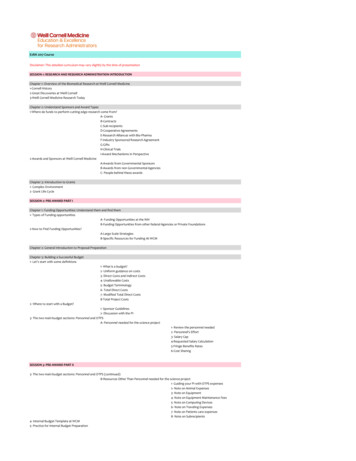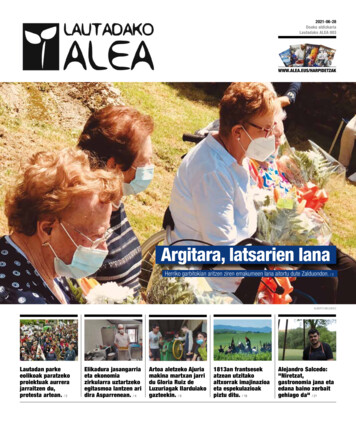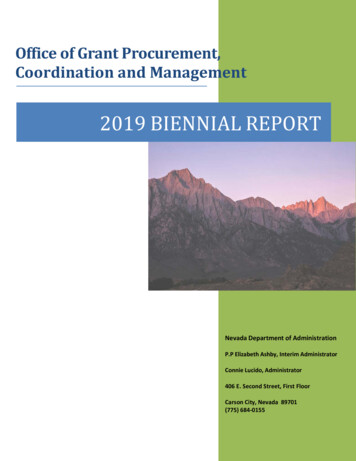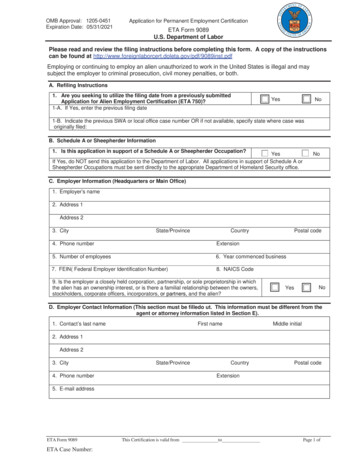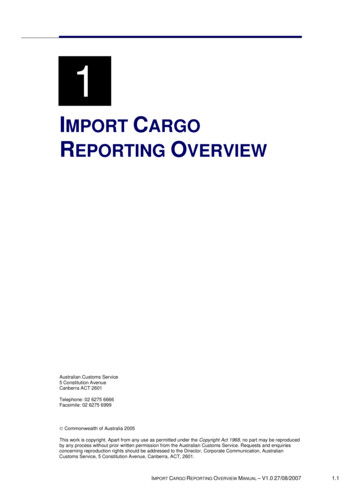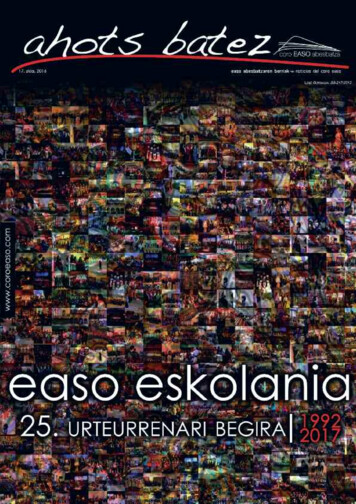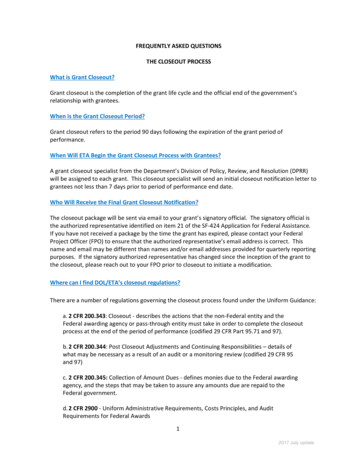
Transcription
FREQUENTLY ASKED QUESTIONSTHE CLOSEOUT PROCESSWhat is Grant Closeout?Grant closeout is the completion of the grant life cycle and the official end of the government’srelationship with grantees.When is the Grant Closeout Period?Grant closeout refers to the period 90 days following the expiration of the grant period ofperformance.When Will ETA Begin the Grant Closeout Process with Grantees?A grant closeout specialist from the Department’s Division of Policy, Review, and Resolution (DPRR)will be assigned to each grant. This closeout specialist will send an initial closeout notification letter tograntees not less than 7 days prior to period of performance end date.Who Will Receive the Final Grant Closeout Notification?The closeout package will be sent via email to your grant’s signatory official. The signatory official isthe authorized representative identified on item 21 of the SF‐424 Application for Federal Assistance.If you have not received a package by the time the grant has expired, please contact your FederalProject Officer (FPO) to ensure that the authorized representative’s email address is correct. Thisname and email may be different than names and/or email addresses provided for quarterly reportingpurposes. If the signatory authorized representative has changed since the inception of the grant tothe closeout, please reach out to your FPO prior to closeout to initiate a modification.Where can I find DOL/ETA’s closeout regulations?There are a number of regulations governing the closeout process found under the Uniform Guidance:a. 2 CFR 200.343: Closeout ‐ describes the actions that the non‐Federal entity and theFederal awarding agency or pass‐through entity must take in order to complete the closeoutprocess at the end of the period of performance (codified 29 CFR Part 95.71 and 97).b. 2 CFR 200.344: Post Closeout Adjustments and Continuing Responsibilities – details ofwhat may be necessary as a result of an audit or a monitoring review (codified 29 CFR 95and 97)c. 2 CFR 200.345: Collection of Amount Dues ‐ defines monies due to the Federal awardingagency, and the steps that may be taken to assure any amounts due are repaid to theFederal government.d. 2 CFR 2900 ‐ Uniform Administrative Requirements, Costs Principles, and AuditRequirements for Federal Awards12017 July update
Can Grantees Receive an Extension to the Grant Closeout Period?An extension to the closeout period will be considered and approved on a case‐by‐case basis. Arequest can be made through the grants closeout system during the 90‐day closeout period. Pleasesee page 31 of the Grant Closeout System End User Manual for additional pdfWhat Are the Financial Concerns?Within 45 days after the period of performance end date, grantees must submit: FINAL ETA 9130 – submitted via the Grantee Reporting ntee prod/reporting/index.cfmNote: Be sure to mark Box 6 as “Final”Within 90 calendar days after the period of performance end date, grantees must submit all closeoutdocumentation (see below) as described through the Grant Closeout System: 9130 Final Quarter and Closeout 9130Grantee’s ReleaseGovernment Property Inventory Certificationo Inventory ListGrantee’s Detail Statement of Costso NICRA & breakdownGrantee’s Assignment of Refunds, Rebates and CreditsGrantee’s Close‐out Tax CertificationNote: For more information on this, please visit http://www.doleta.gov/grants/grant closeout.cfm.Will We Be Required To Provide A Report of Ending Financial Information That Describes the SF‐424A Categories?Yes. Grantees will be required to provide a Detailed Statement of Costs that will be consistent withthe cost categories contained in the SF‐424A budget.Will We Be Required To Submit Details on Administrative Cost Calculations or Leveraged ResourceCalculations or Anything Else in Addition to the ETA‐9130?Administrative costs are to be reported on the ETA‐9130 as well as the final and closeout ETA‐9130reports. Leveraged resources will be reported in the recipient’s share section of the final and closeoutETA‐9130.Note: Any leverage resources that are provided under the award should be tracked and recordedquarterly on the ETA‐9130 financial reports that are submitted.22017 July update
What Activities (Programmatic & Fiscal) Must Cease By the End of the Grant Period?When a funding period for incurring expenditures is specified the grantee may charge the grantallowable expenditures incurred during the funding period. No additional costs may be incurred afterthe expiration of the grant. Grantees must liquidate expenditures (pay bills) properly incurred duringthe award and have 90 days to do so. The Closeout Grant Officer may consider and extend the 90‐dayliquidation timeframe at the request of the grantee. Any costs incurred after the expiration of thegrant are unallowable as direct costs.An example of allowable liquidation of expenditures is the payment of staff salaries accrued during theperiod of performance, but for which pay day falls after the end date of the grant. Please rememberthat a grantee cannot deviate from their established personnel and payroll policies to accrue moresalary expenses during closeout.REMINDER: ETA requires grantees to report all financial transactions on a full accrual basis. Anaccrued expenditure is defined in the ETA‐9130 form instructions and in TEGL 28‐10 Federal FinancialManagement and Reporting Definitions as “costs for goods or services received regardless of whetherpayment has been made”. See 20 CFR 667.107(2)(e) for additional information on period ofavailability.What are ETA Expectations for Liquidating Obligations?If services or goods have not been rendered or received prior to the expiration of the grant , then anyliquidation of existing obligations can NOT occur. As previously stated, the only liquidation that occursduring closeout is the liquidation of accrued expenditures – goods or services rendered or receivedduring the period of performance.Can We Charge Staff Time for Closeout Activities to the Grant?If grant funds cannot be used following the end of the period of performance, how do granteesreimburse for staff salaries for closeout activities such as performance reporting?Under your grant, there are direct and indirect costs. Under the OMB cost principles (2 CFR 220, 225,230), direct costs are those that can be identified specifically with a particular final cost objective, i.e.,a particular award, project, service, or other direct activity of an organization. Indirect costs are thosethat have been incurred for common or joint objectives and cannot be readily identified with aparticular final cost objective. After direct costs have been determined and assigned directly toawards or other work as appropriate, indirect costs are those remaining to be allocated to benefitingcost objectives. A cost may not be allocated to an award as an indirect cost if any other cost incurredfor the same purpose, in like circumstances, has been assigned to an award as a direct cost.Examples of indirect costs may include depreciation or use allowances on buildings and equipment,the costs of operating and maintaining facilities (overhead), top management personnel, fiscaloperations, HR, payroll, and general administration and general expenses. Ordinarily, allowance forthese types of costs will have been included in the organization's indirect cost pool and fundedthrough the application of the approved indirect cost rate across all federal grants. Furtherexplanation of this process is described below:32017 July update
If your organization has more than one federal award, you likely have an indirect cost rate thatwas negotiated with your federal cognizant agency. Closeout activities may be performed byindividuals included in your indirect cost pool and their costs are thus recouped through theindirect charges under your rate made across all your federal grants. Therefore, if the closeoutactivities under your grant are part of your indirect cost pool, those costs are not directchargeable to the grant and would be part of the indirect costs recovered for your grants.However, after the end date of your grant, you would NOT be able to charge indirect costs, asthere are no direct costs to apply your rate to.If your organization does not have an indirect cost rate, but rather an approved cost allocationplan, or closeout activities have been assigned to an individual that has direct charged thegrant, then they may not be reimbursed by ETA or any other grant award as they are directlyassociated with your ETA grant award.What Happens If Our Project Did Not Spend the Entire Amount of the Grant Funds Awarded?Any unexpended funds will be de‐obligated and returned to the Department during the closeoutprocess.What Should We Do if We Used a Provisional Indirect Cost Rate During the Grant Period but Receivea Final Rate During Closeout?Since the final rate would be applicable to a period of performance that occurred prior the closeout,the grantee should make the necessary adjustments to expenses and submit an amended closeoutpackage.What is ETA’s Expectations for the Management and Disposition of Property?The grantee must account for all equipment and supplies by completing a Property Certification Formfor all equipment with a current fair market value of 5,000 or more per unit and any remainingsupplies with an aggregate value of 5,000 at closeout. Equipment is defined as tangiblenonexpendable personal property including exempt property charged directly to the award having auseful life of more than one year and an acquisition cost of 5,000 or more per unit.Supplies are defined as tangible personal property other than those described under Equipment withan total aggregate value of 5,000, regardless of the length of its useful life. The disposition ofequipment must follow the guidelines specified in 2 CFR 200.313 or 2 CFR 439.Acquisition of Real Property is prohibited under these grants; therefore, the items in question wouldfall under equipment or supplies. A reminder – equipment is considered on a unit basis – meaning allthe components required to make it functional – so while individual pieces may be less than 5000, ifthe functional unit total cost is greater than 5000, those combined pieces are considered equipmentand must be inventoried and get disposition instructions if sold.Can a Grantee retain equipment for use on the same project or program for which it was acquiredunder the grant?Your organization may retain the equipment to be used for the purpose under which it wasacquired under the grant as described in 2 CFR 200.313, whether or not the project or42017 July update
program continues to be supported by federal funds. If you elect this option, please indicateyour intent on your submission.Grantee may retain equipment for use on other federally sponsored activities:Your organization may use the equipment in connection with its other federally sponsoredactivities as described in 2 CFR 200.313. If you elect this option, please indicate your intent onyour submission.Grantee may dispose of the equipment by sale(s) or other means:If the organization determines that there is no further use for equipment purchased with ETAgrant funds, the grantee is responsible for disposition of said equipment in accordance with 2CFR 200.313(e) utilizing several methods (transfer, sale, scrap or other means). Items soldshould be reported to DOL as recipients are required to reimburse the DOL agency an amountcomputed by applying to the sales proceeds the percentage of Federal participation in thecost of the original project or program minus 500 or ten percent of the proceeds, whicheveris less, for the recipients selling and handling expenses. Please remit payment, along with abrief statement explaining the nature of the return to:U.S. Department of LaborEmployment and Training AdministrationOffice of Grants Management200 Constitution Avenue, N.W. Rm. N‐4716Washington, D.C. 20210Attn: Closeout Grant OfficerWhat is a Grant Lifecycle?Each demonstration, discretionary, or competitive grant follows a four‐stage lifecycle:A. Pre‐award phase ‐the purpose, amount and conditions of the grant are established by theFederal government.B. Award phase ‐ applicants are solicited and evaluated. A selection is made of one or morerecipients. A grant agreement is executed between the Federal government and the recipient.C. Period of Performance phase ‐ the period of time during which the recipient expends Federalfunds to carry out the purposes and activities specified in the grant agreement. The Federalgovernment exercises oversight and grants management activities.D. Closeout phase ‐ The Federal government reconciles amounts paid with expenditures. Itevaluates the sufficiency of activities under the grant and identifies unobligated balances,disallowed costs and amounts potentially subject to collection.52017 July update
How to return funds (including but not limited to refunds, disallowed costs, etc.)Effective October 1st, 2017, the U.S. Department of Labor, Employment & Training Administrationwill no longer be accepting paper checks for any type of fund returns. All fund returns are to besubmitted electronically through the Payment Management System (PMS) operated by the U.S.Department of Health and Human Resources via the same method as a drawdown.If the PMS document you are trying to apply the refund to is closed or expired, please do thefollowing: Send an email to ETA‐ARteam@dol.gov by copying the following statement,Hello,Please re‐open the following grant, [INSERT PMS GRANT NUMBER WITH SUB‐ACCOUNT] for a refund/return of funds that we need to process. Be sure to insert the full PMS grant number that includes the sub‐account, such as AB12345‐XY0Once your grant is re‐opened you will be sent a confirmation email after which you maysubmit your refund against the PMS grant.If there are questions regarding the return of funds or your organization no longer has access toPMS, contact the U.S. Department of Labor/ETA Office of Financial Administration at www.eta‐ARteam@dol.gov for further assistance.62017 July update
What are the definitions of closeout terms?Administrative cost – costs associated with performing overall general administrative functions,i.e., accounting, financial and cash management, property management, payroll, recordsmanagement etc.Audit – the examination of records, documents and other evidence for the purpose ofdetermining the propriety of transactions and assessing the compliance with relevant cost andaccounting requirements.Budget Realignment – a bi‐lateral modification action, which is agreed upon and signed by boththe Grant Officer and the grant recipient, and adjusts amounts among the line items of the SF‐424a budget document in accordance with actual expenditures. The total amount of the grantbudget remains the same.Closeout Financial Report – an ETA‐9130 financial report, executed by the recipient after thegrant expiration date, to reflect actual and final payments and costs.Closeout phase/Closeout period – the period of time after the grant end date that ETAdetermines that all applicable administrative actions and required work of the grant have beencompleted by the recipient and ETA. This period is used by the recipient to liquidate remainingobligations under the grant and to prepare and transmit final fiscal and program documents. Itmarks the end of the grant agreement between ETA and the recipient.Closeout Resolution Specialist (CRS) – ETA staff assigned to receive and review grant closeoutdocuments, perform a financial reconciliation and assist the recipient in fulfilling its closeoutobligations.Cognizant Agency – the Federal agency that is responsible for approving indirect cost rateagreements/cost allocation plans for a recipient organization.Cost Allocation Plan (CAP) – a method of attributing costs arising from the same activityproportionally to different revenue streams based on benefit received. The written document(cost allocation plan) is prepared by the grantee and the cognizant agency to support the coststhat have been incurred.End User Manual – an electronically transmitted package that is made available to the recipientto initiate the closeout process. It contains instructions and required documents for closeout.Equipment – tangible, nonexpendable personal property having a useful life of more than oneyear and an acquisition cost of 5,000 or more per unit. Acquisition of equipment requires priorapproval from an ETA Grant Officer as a condition of the grant agreement. Equipment is alsoknown as property.Federal Project Officer (FPO) – ETA staff assigned to carry out oversight and grants managementactivities to assist the recipient during the grant period of performance and closeout.Grant Closeout System (GCS) – ETA’s electronic closeout system used for the submission of thegrantee’s closeout package.72017 July update
Grant Officer for Closeout – The Grant Officer specifically charged with timely execution of allactivities during the closeout phase.Indirect Cost Rate Agreement – an agreement between a recipient and its Federal cognizantagency which establishes the proportion of operating costs, such as electricity, insurance orcompensation for an Executive Director, which cannot be directly and uniquely attributed to asingle funding source. The indirect cost rate agreement establishes provisional and final rates atwhich the recipient can be reimbursed by the grant for such activities.Intellectual Property – an intangible product which has value as a commodity, including but notlimited to trademarks, copyrights, patents and patent applications.Liquidate – to satisfy financial obligations by paying owed amounts.Match – additional non‐Federal resources expended to further the grant objectives, if requiredeither by statute or within the grant agreement as a condition of funding. Failure to provide thematch amount by the grant expiration date results in a potential disallowance and debtestablished by the government.Obligation – creation of a legally‐binding agreement, for example payment by a recipient to athird party for goods or services.Payment Management System (PMS) – an electronic fund transfer system operated by the U.S.Department of Health and Human Services. ETA is a customer. Recipients use PMS todrawdown grant finds.Performance Certification – a document executed by the Federal Project Officer which evaluatesthe sufficiency of the recipient activities under the grant.Program income – gross income earned by the recipient that is directly generated by a grantsupported activity or earned as a result of the award. Program income includes but is not limitedto income from fees for services performed, the use or rental of real or personal propertyacquired under Federally‐funded projects, the sale of commodities or items fabricated under anaward, license fees and royalties on patents and copyrights and interest on loans made withaward funds. However, interest earned on advances of Federal funds and tuition costs are notconsidered program income. Such income is added to the award and expended for the samepurposes. Unspent program income is subject to a request for refund during the closeoutphase.Property – equipment acquired under the grant to support grant activities. Title vests with therecipient; however, the Federal government retains an equity interest in all such property andissues disposition instructions during the closeout period.Recipient – an organization receiving financial assistance directly from ETA to carry out a projector program, also known as the grantee.Refund – the Grant Officer for Closeout may determine that certain uses of grant funds are notallowable, or are in excess of established limits. Other revenue streams which support the grant82017 July update
may not reach agreed upon thresholds. These amounts are recovered from the recipientthrough a refund.Sub‐recipient – the legal entity to which a sub‐award has been made by the recipient, and whichis accountable to the recipient for the use of the funds provided.92017 July update
Federal awarding agency or pass‐through entity must take in order to complete the closeout process at the end of the period of performance (codified 29 CFR Part 95.71 and 97). b. 2 CFR 200.344 : Post Closeout Adjustments and Continuing Responsibilities - details of
